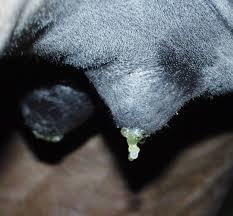Before foaling season it is a good idea to have a good grasp of what is normal leading up to, during, and after foaling. By understanding what is normal vs. what is abnormal, you know when to seek assistance during or after foaling, which is key to ensuring that both your mare and foal survive the event safely.
The normal gestation length for a mare is 342 days. However this can vary considerably, and can range from 315 to 400 days. Udder development usually starts 3 to 6 weeks prior to foaling, but may occur earlier in maiden mares. Udder development prior to this may indicate that the mare is going to abort the foal. It is a good idea to get your vet to examine your mare if she develops an udder more than 2 months away from foaling.
Predicting when your mare will foal can be very difficult. The two most commonly used indicators are softening of the ligaments around the base of the tail and “waxing-up”. Waxing is the appearance of beads of wax-like material on the ends of the teats(Pictured).
Waxing occurs in about 95% of mares 6 to 48 hours before foaling, however it can also occur several days before foaling, or sometimes not at all. Other tests that are sometimes used to predict foaling in mares are testing of the chemical make-up of the milk and a drop in body temperature the day before foaling. Neither of these methods are reliable for accurately predicting the day of foaling.
The actual process of foaling is divided into 3 stages. The first stage is characterized by obvious changes in the mare’s behaviour. She will become restless, often walking the paddock aimlessly, she may show signs of colic (intermittent lying and standing, pawing at the ground, rolling) and may have patchy areas of sweating, especially over the shoulders and flanks. Inside the mare during this time the foal turns from its normal position of lying on its back to one where its backbone is next to the mare’s backbone with its head facing towards the mare’s tail. The cervix begins to dilate and the uterus begins to contract. First stage labor ends when the membranes rupture (“waters breaking”). On average, first stage labor lasts about one hour, but can range from 5 minutes to 3 hours. First stage labor lasting more than 3 hours can indicate a problem and the mare should be examined by a vet immediately.
The second stage of labor is the period when the foal is actually delivered. It is characterized by strong abdominal contractions and the appearance of the foal’s feet at the vulva.
Most mares foal lying down and they should not be forced to remain standing during delivery if it is progressing normally. The white membrane (amnion) that surrounds the foal should appear at the vulva within 5 minutes of the waters breaking. One foot usually appears 5-10cm in front of the other foot and the soles of the feet should be pointing downwards. The foal’s head normally rests between the knees. Second stage labor should take less than 20 minutes. Virtually all foals (98.9%) are delivered with the front feet and head first (anterior presentation), 1% of foals are presented in posterior presentation (breech) and 0.1% (1 in 1000) are found in a crossways presentation. Both posterior and crossways presentations are abnormal and veterinary assistance is required immediately.
The third stage of labor involves the expulsion of the membranes which usually takes between 10 minutes and 3 hours. If the membranes are still present 6 hours after foaling, call your vet.
Once your mare starts foaling the temptation to rush-in and lend a helping hand is hard to resist. Remember, 95% of mares will foal with no complications and require no assistance at all. Intervening during a normal foaling can do more harm than good. Nervous mares (especially maidens) will often stop straining and walk off if disturbed. This could delay the foaling process, and put the foal’s life at risk. There are several guidelines which can help you decide when assistance is required:
- Stage 1 labor longer than 3 hours
- Stage 2 (straining) longer than 20 minutes
- Appearance of the “red bag” at the vulva (this is an emergency because it means that the membranes have not ruptured – the foal could suffocate)
- White bag appears (inner membranes) but no body parts
- Active straining but no progress
- Absence of straining
- Appearance of only one hoof at vulva
- Hooves upside down
- Hooves above nose
- Head presented with no hooves or only one hoof
- Foal’s tail presented
If you encounter any of the above, phone your vet immediately. All vets understand the need for urgency during an assisted foaling, and will not be concerned if she foals while they are on the way to your place. If in doubt, call your vet. While waiting for your vet to arrive there are several things that you should do: wrap the mare’s tail, keep the mare walking and don’t let her lie down. By keeping her walking she is less likely to strain, which will prevent her from doing more damage if she is in difficulty.
Never push against the mare while she is straining – this could rupture her uterus
When dealing with a foaling mare remember that her behaviour changes. Sometimes, normally placid mares can react in an aggressive way towards people – this is a normal protective mechanism. Also, if trying to examine the mare’s vulva be careful of her back legs, mare’s will sometimes kick out in response to the pain of foaling.
After delivering the foal most mares will continue to lie-down for 5-10 minutes, exhausted after the effort of abdominal straining. The foal should be sitting-up within 2 minutes of birth and should stand within an hour.
It should be able to suckle the mare unaided within 2 hours. If the foal does not behave in this way within these time periods, seek veterinary advice.
Both the mare and foal should be watched closely for the first 24-48 hours after birth.  Make sure that the mare is eating normally, and is not depressed. Signs of colic, depression or lack of appetite could indicate a post-foaling complication such as internal bleeding, uterine infection or peritonitis. The foal should be monitored to ensure that it is feeding normally, and is urinating and defaecating. Straining to pass faeces or signs of colic could indicate meconium impaction which will need veterinary treatment.
Make sure that the mare is eating normally, and is not depressed. Signs of colic, depression or lack of appetite could indicate a post-foaling complication such as internal bleeding, uterine infection or peritonitis. The foal should be monitored to ensure that it is feeding normally, and is urinating and defaecating. Straining to pass faeces or signs of colic could indicate meconium impaction which will need veterinary treatment.



